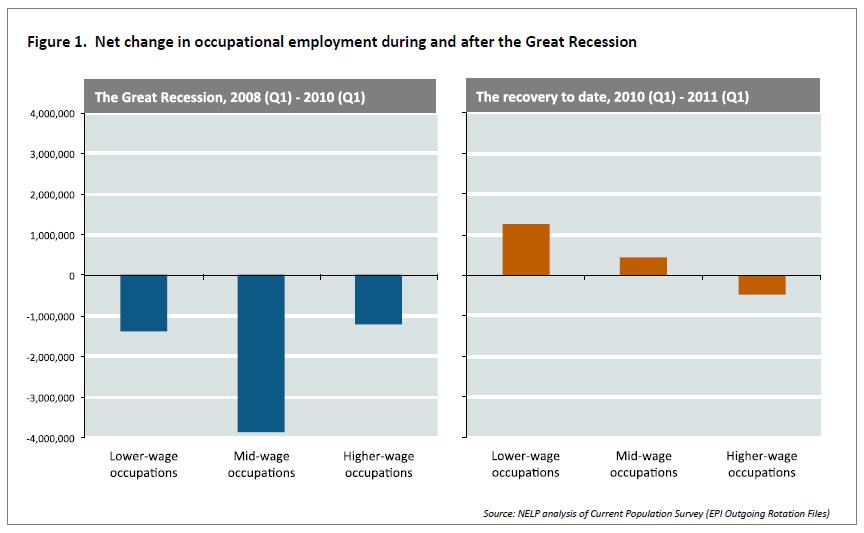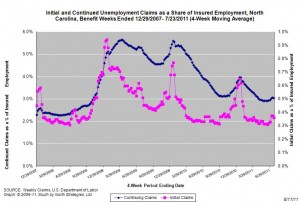12.08.2011
Policy Points
Economic policy reports, blog postings, and media stories of interest:
12.08.2011
Policy Points
In an update to previous research, the National Employment Law Project finds that America’s “good jobs” gap has continued to grow.
As the graph below shows, job losses have occurred overwhelmingly in mid-wage occupations (paying $13.53 to $20.66 an hour in 2011), while job growth has occurred primarily in low-wage occupations (paying $7.51 to $13.52 an hour in 2011).

12.08.2011
Policy Points
For the benefit week ending on July 23rd, 9,992 North Carolinians filed initial claims for state unemployment insurance benefits, and 109,753 individuals applied for state-funded continuing benefits. Compared to the prior week, there were fewer initial and continuing claims. These figures come from data released by the U.S. Department of Labor.
Averaging new and continuing claims over a four-week period — a process that helps adjust for seasonal fluctuations and better illustrates trends — shows that an average of 13,365 initial claims were filed over the previous four weeks, along with an average of 113,152 continuing claims. Compared to the previous four-week period, the averages of initial and continuing claims were somewhat lower.
One year ago, the four-week average for initial claims stood at 13,822 and the four-week average of continuing claims equaled 142,647.
While the number of claims has dropped over the past year so has covered employment. Last week, covered employment totaled 3.72 million, down from 3.76 million a year ago.
 The graph shows the changes in unemployment insurance claims (as a share of covered employment) in North Carolina since the recession’s start in December 2007.
The graph shows the changes in unemployment insurance claims (as a share of covered employment) in North Carolina since the recession’s start in December 2007.
Both new and continuing claims appear to have peaked for this cycle, and the four-week averages of new and continuing claims have fallen considerably. Yet continuing claims remain at an elevated level, which suggests that unemployed individuals are finding it difficult to find new positions.
11.08.2011
Policy Points
Economic policy reports, blog postings, and media stories of interest:
11.08.2011
Policy Points
The latest issue of Carolina Context, a publication of the UNC Program on Public Life, summarizes the findings of a two-year study into how the future of North Carolina’s Eastern Region can be viewed “as a metropolitan opportunity rather than a rural problem.” From the report’s conclusion …
As identified in our inquiry and interviews, the region has significant assets—miles and miles of coastline and riverfront property, 11 community colleges, two military installations and related communities, and East Carolina University, the state’s third-largest public university by total student head-count, second-ranked in undergraduate enrollment. The challenge that emerges from our study is how to take fuller advantage of these assets to expand business opportunities, to provide more jobs for residents, to lift personal income and to enhance the quality of life.
…
And yet, we found that barriers anchored in history continue to inhibit economic vitality and progress. Barriers include lingering racial attitudes and intra-community rivalries. Still, we found residents of the region eager to talk about their aspirations and the course of their communities.
The report continues …
The region can no longer count on tobacco and small-shop manufacturing as its economic foundation. Likewise, Eastern North Carolina can no longer count on its current crop of long-time leaders of the baby-boom generation, many of whom will surely age out of their leadership roles after many years of service. Discussions of the region’s future often turn to the need for fresh leadership. Young professionals in the East appear less invested in old rivalries between towns and more concerned with building communities that work for themselves and their children. Thus, local and regional governments, businesses, nonprofits and schools should create mechanisms to engage young adults in informed conversations on the future of the region.



 Email Sign-Up
Email Sign-Up RSS Feed
RSS Feed